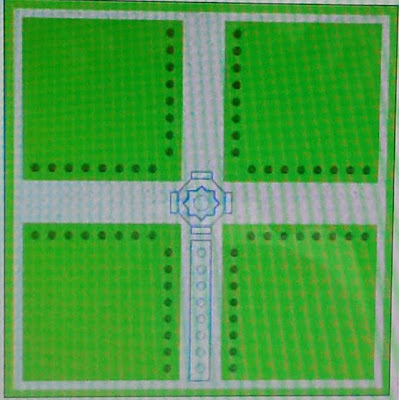150 years old Bombax Tree (Silk Cotton Tree), standing tall, majestic and wide, posing a silent patient calm witness to 3 passing centuries - Imperial India, British India, Post Independent India and confidently looking up to the global, growing, challenging India !

150 year old Bombax tree at Lal Bagh
Yes it is a museum piece and how I stumbled upon it is even more interesting.
I on my holiday with my 10 year old son, wanted to explore my native city and a dear friend suggested ‘why not start with a green walk to know our favourite childhood picnic spot- Lalbagh’.
The walk took me down the history lanes bringing to memory famous French poet and critic, Nicholas Boileau Despreaux words on Nature - “Nature always springs to the surface and manages to show what she is. It is vain to stop or try to drive her back. She breaks through every obstacle, pushes forward, and at last makes for herself a way.”
Lalbagh Garden, situated in the heart of Bengaluru city, State of Karnataka, India, a Green Museum, houses such tale-telling, green living artifacts. To be specific - the garden is 251 years old, home to 1854 species of trees and plants native to South America, Middle East, Japan and South East Asia and 40 species of birds and a 40 acre Water body spread over 180 acres of land. The botanical garden also has a National Geographic Monument in the form of a rock formation of 3 billion years old, more than half as old as the Earth itself ! Indeed it is older than the rock formations in Grand Canyon and the Himalayas. Isn’t ‘a National Treasure’ a better name?
It all started with Kempe Gowda, founder of the city of Bengaluru in the 16th century choosing a rock mound to mark the city’s southern boundary and built a watch tower on it. In 1760, Nawab Hyder Ali the then commander of the Mysore Army set up a Rose and Cypress Garden a few hundred yards west of the watch tower. This garden was built on the lines conforming to the Islamic Ideal of ‘Paradise’ of the Moghul Gardens at Sira in Tumkur near Bengaluru...when all the aspects are studied in totality, the highlighting objective of this (Lalbagh's) design is to add to a person’s life by providing stress purification as well as spiritual purification - an embodiment of a Spiritual Vision with Universal Appeal!
There are differences in conceptualization and perception of the gardens conforming to Islamic Ideal of Paradise with others. Islamic Garden is a prime example of the concept of blending Heaven and Earth to produce a Spiritual symbolic Sanctuaries. The word ‘Paradise’ comes from the Persian word - ‘ Pairidaeza’ - ‘Pairi ( around) and ‘daeza’ ( wall) broadly referring to something with a wall around it and eventually came to mean a ‘walled garden’.
 To understand and appreciate this ‘Ideal of Paradise’ by a lay person, which was widely used by the Moghul rulers in India and elsewhere in the world and which has gracefully stood witness to generations on and has been heralded as World Heritage, some specifications to be followed will be helpful.
To understand and appreciate this ‘Ideal of Paradise’ by a lay person, which was widely used by the Moghul rulers in India and elsewhere in the world and which has gracefully stood witness to generations on and has been heralded as World Heritage, some specifications to be followed will be helpful.First and most striking aspect is the wall surrounding the garden’s exterior.This is in complete contrast to the western perspective, where a garden is open to public viewing and emphasises more on external aesthetics. In the Islamic Ideal of Paradise, the walls enclose tranquility, thereby separating sacred from the busy, hectic world! Second aspect being the garden has it’s specific layout - a four fold layout - the Char-Bagh concept. Classically the Char-Bagh is constructed around a central pool or a fountain with four streams flowing from it representing the four main elements of Life. This can be seen in the layout of the Wonder of the World, Taj Mahal at Agra and also the magnificent Shalimar Gardens in Srinagar.The third feature is the presence of water in a form of pool or fountain.The fourth feature is the Garden Pavilion, serving as a shaded retreat from a long day of work or world’s troubles ! This can be seen in the form of a handsome and spacious Glass house built on the model of Crystal Palace in the Lalbagh Garden and serves as an exhibition hall for flower and fruit exhibition held seasonally.
Since idolatry is prohibited, the garden is decorated with ornamentation with geometrical interlacing work using plants. This is called Arabesque, designing with idealized styling plants and vines to create geometric patterns.Experts term it as an intrinsic combination of Architecture and Cosmology.
These Gardens are a step towards creating a reflection of God’s beauty by using what He has provided. This is echoed in the words of Rabhindranath Tagore, “Trees are the Earth’s endless effort to speak to the listening Heaven”.
This was the history, heritage and aesthetic angle, but another interesting aspect is the variety of Flora and Fauna found in the Lalbagh Gardens - both native and exotic, which has been continuously enhanced by all the successive inheritors from Nawab Hyder Ali, his son Tipu Sultan to British Colonists and the Post Independent Progressive Indians.
Today standing as a public Botanical Garden it exemplifies as a Multifunctional Green Living Museum. The role donned by this treasure house is quiet long -
- an educational and scientific tool for universities and schools
- a complete collection of coloured botanical drawings of indigenous plants;
- a strictly protected natural territory;
- a city’s natural memorial;
- a resource for city greening;
- a platform for horticultural innovations - annual flower shows and Seasonal Fruit Melas;
- a biodiversity conservation and its rational use;
- a plant gene bank and a seed bank;
- a public park for tourism and recreation;
- a horticulture therapy tool;
- a promoter of internal cooperation.
As Thomas Binney, English Congregationalist of the 19th century popularly known as the Archbishop of Non-conformity comments on Nature very appropriately -
“Nature is the most thrifty thing in the world, she never wastes anything, she undergoes change but there’s no annihilation, the essence remains- matter is eternal.”
All together an enriching experience - History, Nature, Discovery and Heritage all over a Morning Walk!


No comments:
Post a Comment